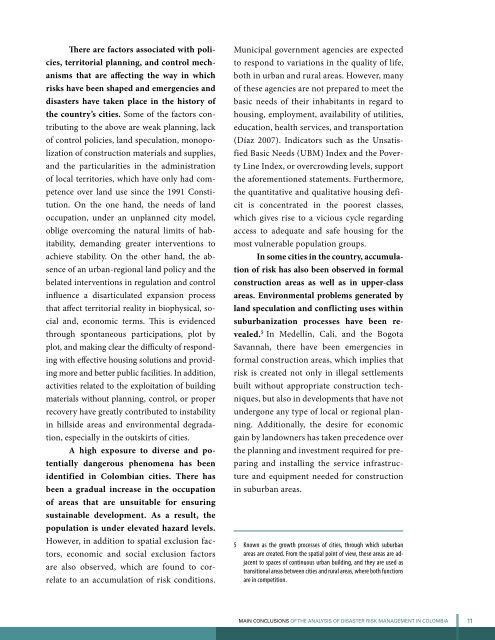Executive Summary - GFDRR
Executive Summary - GFDRR
Executive Summary - GFDRR
Create successful ePaper yourself
Turn your PDF publications into a flip-book with our unique Google optimized e-Paper software.
There are factors associated with policies,<br />
territorial planning, and control mechanisms<br />
that are affecting the way in which<br />
risks have been shaped and emergencies and<br />
disasters have taken place in the history of<br />
the country’s cities. Some of the factors contributing<br />
to the above are weak planning, lack<br />
of control policies, land speculation, monopolization<br />
of construction materials and supplies,<br />
and the particularities in the administration<br />
of local territories, which have only had competence<br />
over land use since the 1991 Constitution.<br />
On the one hand, the needs of land<br />
occupation, under an unplanned city model,<br />
oblige overcoming the natural limits of habitability,<br />
demanding greater interventions to<br />
achieve stability. On the other hand, the absence<br />
of an urban-regional land policy and the<br />
belated interventions in regulation and control<br />
influence a disarticulated expansion process<br />
that affect territorial reality in biophysical, social<br />
and, economic terms. This is evidenced<br />
through spontaneous participations, plot by<br />
plot, and making clear the difficulty of responding<br />
with effective housing solutions and providing<br />
more and better public facilities. In addition,<br />
activities related to the exploitation of building<br />
materials without planning, control, or proper<br />
recovery have greatly contributed to instability<br />
in hillside areas and environmental degradation,<br />
especially in the outskirts of cities.<br />
A high exposure to diverse and potentially<br />
dangerous phenomena has been<br />
identified in Colombian cities. There has<br />
been a gradual increase in the occupation<br />
of areas that are unsuitable for ensuring<br />
sustainable development. As a result, the<br />
population is under elevated hazard levels.<br />
However, in addition to spatial exclusion factors,<br />
economic and social exclusion factors<br />
are also observed, which are found to correlate<br />
to an accumulation of risk conditions.<br />
Municipal government agencies are expected<br />
to respond to variations in the quality of life,<br />
both in urban and rural areas. However, many<br />
of these agencies are not prepared to meet the<br />
basic needs of their inhabitants in regard to<br />
housing, employment, availability of utilities,<br />
education, health services, and transportation<br />
(Díaz 2007). Indicators such as the Unsatisfied<br />
Basic Needs (UBM) Index and the Poverty<br />
Line Index, or overcrowding levels, support<br />
the aforementioned statements. Furthermore,<br />
the quantitative and qualitative housing deficit<br />
is concentrated in the poorest classes,<br />
which gives rise to a vicious cycle regarding<br />
access to adequate and safe housing for the<br />
most vulnerable population groups.<br />
In some cities in the country, accumulation<br />
of risk has also been observed in formal<br />
construction areas as well as in upper-class<br />
areas. Environmental problems generated by<br />
land speculation and conflicting uses within<br />
suburbanization processes have been revealed.<br />
5 In Medellin, Cali, and the Bogota<br />
Savannah, there have been emergencies in<br />
formal construction areas, which implies that<br />
risk is created not only in illegal settlements<br />
built without appropriate construction techniques,<br />
but also in developments that have not<br />
undergone any type of local or regional planning.<br />
Additionally, the desire for economic<br />
gain by landowners has taken precedence over<br />
the planning and investment required for preparing<br />
and installing the service infrastructure<br />
and equipment needed for construction<br />
in suburban areas.<br />
5 Known as the growth processes of cities, through which suburban<br />
areas are created. From the spatial point of view, these areas are adjacent<br />
to spaces of continuous urban building, and they are used as<br />
transitional areas between cities and rural areas, where both functions<br />
are in competition.<br />
MAIN conclusions of the ANALYSIS of disaster risk management in Colombia 11

















